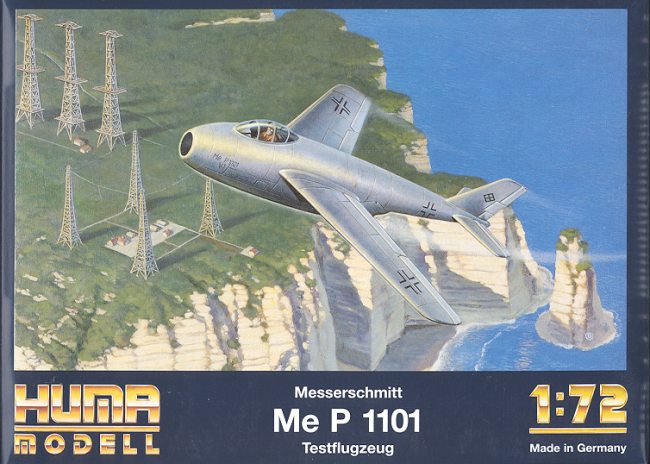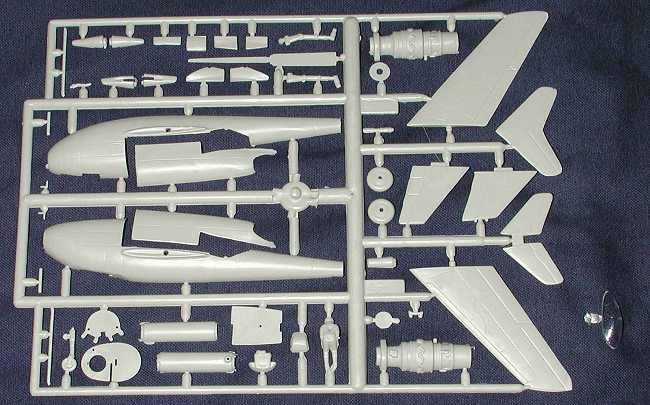
|
KIT: |
Huma 1/72 Messerschmitt P.1101 |
|
KIT # |
3001 |
|
PRICE: |
$18.98 |
|
DECALS: |
One aircraft |
|
REVIEW & |
|
|
NOTES: |

|
HISTORY |
The Messerschmitt P.1101 was a design that was started in early 1944 as a test aircraft. Messerschmitt was sure that swept wing technology was to be the next step in aerodynamics and wanted to build an aircraft that would be able to prove his research. What he needed was a small aircraft and a design that would be able to be 'adjusted'. To this end, the wing was designed to be able to have the sweep adjusted between 35 and 40 degrees. This was done to enable them to determine the most effective sweep angle for future aircraft. This wasn't an automatic feature, but something that required the wing to be repositioned by a ground crew.
When the Emergeny Fighter Competition came about later in 1944, Messerschmitt fixed the wing sweep at 40 degrees and came up with a proposal based on this design. It was being built using a Jumo 004B engine as the Heinkel one wasn't ready. When discovered by US troops at the end of the war, it was about 80% complete. The airframe was whisked away to the US where it was hoped that it could be completed and flown, however, the handling of the plane was not done well and it was so damaged that it was deemed unsuitable for flight.
The aircraft was then given to Bell who basically scaled up the plane and added a wing that could automatically be swept in flight from 20 to 60 degrees. This was the X-5 and it was instrumental in continuing research into the effects of swept wings. What happened to the original P.1101 is unknown, though it probably ended up on the scrap heap.
|
THE KIT |

This is another of Huma's later releases, though without the small sprue of fine parts. Same fine detail work, same general overall quality. Where this kit differs is in the number of ways that it can be built. When discovered by US troops, the aircraft was without an engine, though there was a mock-up of the Heinkel one attached. One version of the kit can be built this way, with no engine side covers. When taken to the US and photographed, an American J-35 turbojet was attached to the aircraft and three .50 calibre machine guns were painted on the side of the nose. Again, no engine covers. You can build the kit in this manner as well. Both would be perfectly acceptable for those who don't do Luftwaffe '46 models.
The other two are for those of us who actually like Luft '46 models. This involves having the engine doors attached. There was also a follow-on project that used a T tail. The new fin and horizontal stabilizers are provided in the kit so that this version can also be built. One thing you will have to do is to be creative on where to put nose weight. The design is bound t be tail heavy and thanks to a long intake trunking, there is precious little space for weight. If you plan on doing a fighter version, you'll also have to drill holes in the nose where you think the gun port would be as this is not done for you.
The instruction sheet is quite good in terms of color and markings and parts breakdown. The construction sequence though is nothing more than two exploded views showing all possible permutations. Thankfully, the kit itself is pretty simple and not parts intensive so this method is sufficient to allow you to complete the kit. The colors of the prototype are overall natural metal with no insignia as the plane wasn't competed. The two other options are shown in a splinter pattern of RLM 74/75 over RLM 76, though you can, of course, paint it any way you want. Decals (not shown) are the usual from Huma in that they are matte, have lots of carrier film and fit very well. They consist of crosses and the painted on guns and an instrument panel.
It looks like a very simple kit to build and would be a fine one for those looking to start a Luft '46 collection.
Review kit courtesy of me and my wallet!
If you would like your product reviewed fairly and quickly by a site that averages over 2,500 visits a day, please contact me or see other details in the Note to Contributors.